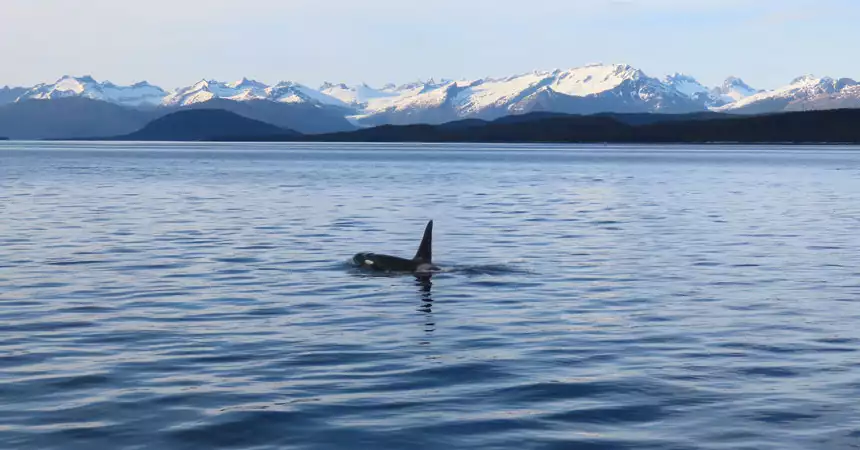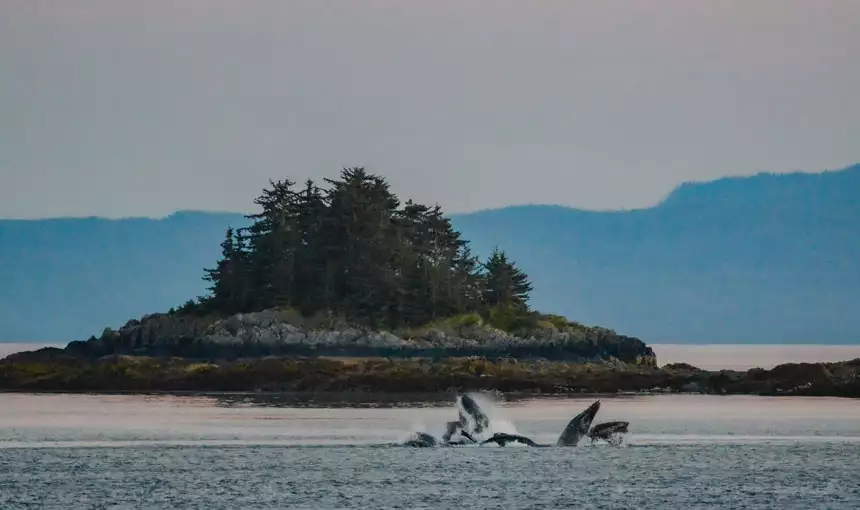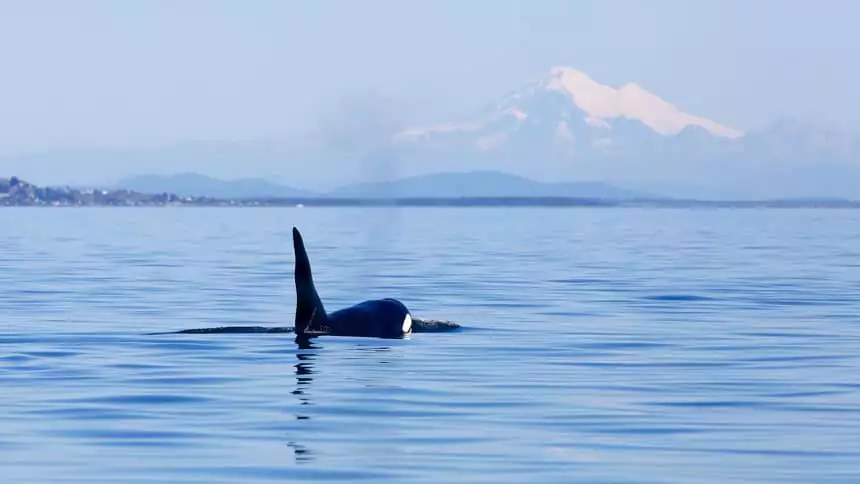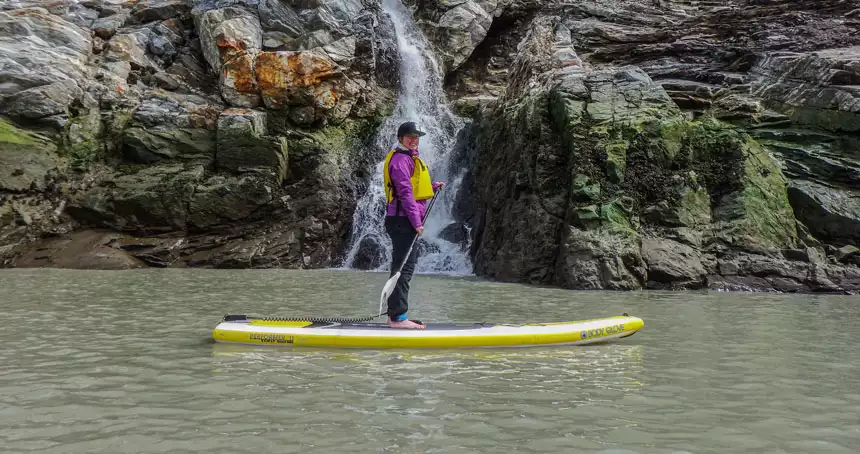Will you see whales on an Alaskan cruise?
Almost certainly. And it will be unforgettable.
In this primer, learn more about whale watching in Alaska, including the types of whales in Alaska, considerations for your Alaska whale watching cruise and why an overnight Alaskan small ship cruise is the best Alaskan cruise for whale watching.
IN THIS POST – Whale Watching in Alaska Aboard Small Ships:
Types of Whales in Alaska
Best Whale Watching Sites in Alaska
Timing Your Alaska Whale Watching Cruise
The Advantage of Whale Watching Aboard Small Ships
Alaska Whale Watching Cruise Deals
Alaska Whale Watching Preparation
More Alaska Resources
Share Your Whale Encounters
Types of Whales in Alaska
The Last Frontier plays host to various whales in Alaska, including gray whales, Baird’s beaked whales, blue whales, fin whales, humpback whales, minke whales, orca or killer whales, bowhead whales, sperm whales, beluga whales and narwhals.
On an overnight Alaska cruise for whales in Southeast Alaska’s Inside Passage, or while whale watching Prince William Sound, expect to commonly see humpback whales, as well as orcas in Alaska and minke whales in Alaska. Here we delve deeper into each of these commonly sighted whales in Alaska.
Humpback Whale Watching in Alaska
Humpbacks are the most sighted whales during Alaska whale watching cruises. Humpback whales are about 40 feet long, they can weigh roughly 40 tons (about the size of a city bus) and they can live around 40 years. Humpbacks spend their summers in the feeding grounds of Alaska’s nutrient-rich waters; and their winters mating and birthing calves in Hawaii and Baja. This journey is one of the longest and most amazing migrations of any animal on the planet.
Humpbacks are baleen whales known for lunge and bubble net feeding. They work collectively to blow a “net” of bubbles that corrals fish and krill into a column before they jointly lunge to the surface, swallowing huge mouthfuls of food. During the summer, humpback whales in Alaska gather in feeding pods near rich food sources caused by up-welling currents, making their behavior and location predictable for Alaska whale watching cruises.
Humpback whales in Alaska are known for their acrobatic behavior: tail slapping, pectoral fin slapping, spy hopping and breaching completely out of the water. Humpbacks are named for the distinct arching of their back that often precedes a deep dive.
Whale Watching Alaska Pro Tip: When you see the humped back, get your camera ready because these whales in Alaska often show their huge fluke tail—which itself can reach up to 15 feet wide—before going down.
Orca Whale Watching in Alaska
Orcas in Alaska are the largest member of the dolphin family and are of course, toothed whales. They can grow up to about 28 feet long and are easily recognizable by their distinct black and white markings and dorsal fin which can extend up to 6 feet in large males. Wild orcas nearly match humans with their long lifespan and wide distribution.
Orcas can travel up to 100 miles per day, making their behavior more unpredictable than humpbacks. We estimate that orcas in Alaska are seen about every third orca whale watching cruise so if you see them, consider yourself very lucky.
Orcas spend their life in the same matriarchal family group called a pod. Each pod has distinct calls or language and family bonds are strong. Scientists generally recognize three types of orca pods: resident, transient and open ocean.
- Resident pods stay in the same geographical area (although this area can be huge) and typically feed on fish. Transient pods range farther afield and feed on other marine mammals.
- Transient pods may work together, like a pack of wolves, to prey upon animals much larger than themselves, including other whales.
- Open ocean pods are the least known of all orcas and spend their lives away from the coast.
Orcas in Alaska and pods around the world have developed unique styles of hunting with distinct behaviors and languages, leading some scientists to consider different groups as races.

Seeking the Minke Whale in Alaska
The minke whale in Alaska is both the most populous and the most discreet. Minkes are the smallest of the “great” baleen whales and can grow up to 35 feet long and weigh up to 10 tons. They have a small curved dorsal similar to a dolphin that only breaks the surface for a moment when they come up to breathe, making minke whales difficult to see.
Like humpbacks, minke whales in Alaska feed on small fish and krill, however they usually work alone and don’t congregate in predictable feeding pods. Some minkes do migrate but many minke whales in Alaska are resident and stay in Alaskan waters year-round. Despite their reclusiveness, minkes are known to spy hop, tail slap or even breach the surface. If you see a minke on your Alaska whale watching cruise aboard a small ship, consider yourself an expert whale watcher.
Best Whale Watching Sites in Alaska
Alaska cruise whales are commonly sighted in coastal waters and travelers should be looking throughout their voyage. But some areas are known whale gathering spots. If whale watching Alaska is important to you, plan a small ship cruise that includes the following areas on your itinerary.

Whale Watching Alaska in Glacier Bay
Glacier Bay National Park and Preserve is a fantastic place to watch whales in Alaska. It’s also a popular place for whale research, due to its strong protection for whales. Ships need special access permits, intentionally reducing ship volume to allow whales to easily enter and exit the bay.
Humpback whales in particular like the bay’s rich nutrients generated by glacial activity combined with strong tidal currents mixing deep and shallow waters. In fact, it was in Glacier Bay where bubble net feeding behavior was first observed and studied. Additionally, an abundance of marine mammals including harbor seals, Stellar sea lions and strong salmon runs make Glacier Bay a popular hunting ground for orcas in Alaska.
Whale Watching Alaska in Frederick Sound
At the south end of Admiralty Island, known for the highest concentration of brown bears in the world, lies Frederick Sound. Loosely defined as the waterway south of Stephen’s Passage and east of Chatham Straight, this crossroads area offers an astounding variety of bays, coves, islands and open water that consistently attracts whales.
For all the reasons described above, this area is home to humpback whales, orcas in Alaska and minke whales in great numbers. It is also home to a plethora of other marine mammals including harbor seals, Stellar sea lions, harbor porpoise, Dall’s Porpoise and sea otters.
Whale Watching Alaska Pro Tip: If your Alaska whale watching cruise does not include Glacier Bay, consider an itinerary that includes Frederick Sound—most Alaska Inside Passage cruises do.

Whale Watching Alaska at Point Adolphus
Just outside of Glacier Bay National Park sits Point Adolphus, one of the premier sites for whale watching Alaska. In fact, the entire Icy Strait region, of which Point Adolphus is a part, offers outstanding whale watching. Many Inside Passage whale watching cruises on small ships will combine a visit to Glacier Bay with a day in the Icy Strait, Point Adolphus region.
Huge tides as high as 30 feet move a tremendous amount of water in and out of Alaska’s Inside Passage. The northernmost opening to the Pacific Ocean is the west end of Icy Strait where water rushes in, mixes with nutrient-rich water from Glacier Bay, and must pass by Point Adolphus. The waters in this area can be hundreds of feet deep just offshore, creating an incredible amount of upwelling and mixing.
The currents also work to herd krill and small fish into compact columns where they are easily consumed by mighty whales. This bounty of food also attracts other marine mammals and you may find sea lions trailing behind humpback whale pods, picking off larger fish escaping the huge mouths of whales. This region is also home to a large number of sea otters which can be seen floating in rafts or by themselves, usually near shoreline kelp beds.
Whale Watching Prince William Sound
Prince William Sound (and nearby Kenai Fjords National Park) is a vast waterway close to Alaska’s largest town—Anchorage—and usually accessed by small ship from Whittier. Because of the sound’s size, whale watching day tours have trouble reaching areas where whales congregate. This problem is solved aboard overnight small ship cruises.
Whale watching Prince William Sound offers humpback whales, gray whales, blue whales and minke whales. But the most famous opportunity in this region is orca whale watching. Prince William Sound is home to several resident pods of orcas in Alaska and transients are also known to visit the area in search of abundant marine mammals. Occasionally these pods gather to mix and mate in what are known as superpods in which 50 or more animals may be seen at one time.
Whale Watching Alaska Pro Tip: Whale watching Prince William Sound offers a better chance to see orcas in Alaska than anywhere else in the state.

Timing Your Alaska Whale Watching Cruise
Minke whales in Alaska and orcas in Alaska can be spotted year-round, but the migratory humpback whales are only present from late spring into early fall. Learn more about timing your Alaska whale watching cruise—including our recommendations—in the Alaska whale watching season section of our by-month primer for travel to Alaska.
Whale Watching in Alaska Aboard Small Ships
An Alaska cruise for whales is best done on board one of our small ships to Alaska. Reach remote areas inaccessible to day boats, increase your opportunities to see whales in Alaska with a multi-day program, enjoy a flexible schedule that will pause for whale sightings, spot whales from regular paddle excursions, and appreciate a cruise ship for whale watching that puts you right at “see” level.
Watching whales in Alaska aboard small ships has many advantages over larger cruise ships or whale watching day tours. Flexible itineraries aboard small ships mean you can linger longer when whales are sighted. It’s not uncommon for captains to stop the ship for an hour or two if the whale sightings are good. And over the course of a 7-night itinerary you may have several such encounters.

Small ships are able to venture farther afield to reach the whales, whereas day tours from town are limited to whales that venture close to inhabited areas. Whales can be seen from ferries and large cruise ships but keep in mind that ferries have a schedule to keep so they never stop for whales. It can take a large cruise ship up to two miles to make a complete stop, so they have little interest in stopping for animals; therefore watching whales from 10 stories up as they pass by can be an exercise in frustration.
Another advantage of watching whales from small ships is the ability to get off the ship to view wildlife up close. Many small ships are outfitted with small inflatable crafts that take travelers away from the ship to view whales and wildlife up close. Adventurous travelers may even have the opportunity to encounter whales while kayaking or stand-up paddleboarding. While paddling with whales is a rare occurrence, we can tell you that viewing a 40-ton whale from your kayak or paddleboard is the thrill of a lifetime—as Jenn writes about in her Expert Review: Alaska’s Islands, Whales & Glaciers Cruise.

“As we began to paddle out…A minke whale popped up to the left of me. I sat down on the paddle board and watched as the whale slowly headed off. It felt surreal to be out there within such close reach of so much incredible sea life!”
On small ship Alaska whale watching cruises, the captain and crew are expert whale spotters and they will announce when whales are in the area. The ship’s crew also shares intel with other ships and boats in the region, to help one another find animals. Additionally, onboard naturalist guides enhance your knowledge of whales in Alaska, their habitat and relevant conservation issues. Guides will offer narration and answer questions while viewing whales from the ship. And evening programs may consist of talks and slideshows reviewing whales and other animals encountered on your journey.
Small ship whale watching cruises are geared toward inquisitive travelers who want to learn more about the nature and wildlife they are viewing. For these reasons we feel that small ships are the best way to whale watch in Alaska.
Alaska Whale Watching Cruise Deals
Almost any overnight cruise with small Alaskan cruise lines will involve whale watching. Therefore, when seeking whale watching cruise deals, our Alaska small ship cruise deals have you covered.
Alaska Whale Watching Preparation
Will you see whales on an Alaskan cruise? Almost certainly. But how do you make the most of these unforgettable moments? Here are insights from our team of Alaska whale watching cruise specialists, a group that includes a former Alaska naturalist guide and experts who have lived, worked and explored the region in depth.
Whale Watching Alaska Packing Tips:
- Pack a waterproof jacket and pants, plus warm layers, as Alaska’s climate can vary dramatically.
- A good pair of binoculars is important; we suggest one for each traveler.
- Photographers: a 200-400-millimeter lens is helpful, as is an image-stabilizing lens.
Cameras that shoot several frames per second can capture breaches, tail slapping and flukes more easily than slower cameras. If all you have is a point and shoot, focus on watching the whales yourself and purchase a professional whale image from a local gift shop.
Want more advice? Read our small ship Alaska cruise reviews.

MORE ALASKA RESOURCES:
Alaska Small Ship Cruises
Alaska Yacht Charters
Luxury Alaska Cruises
Alaska Cruise Guide
Alaska Cruise Deals
Small Ship Alaska Cruise Reviews
Best Alaska Cruises for Families
Small Alaskan Cruise Lines
Glacier Bay Cruises
Alaska Inside Passage Cruises
Alaska Trips
Alaska Tours
Visiting Denali National Park
Alaska National Park Tours
Best Time to Visit Alaska
Share Your Encounters Whale Watching Alaska
Tell us about your Alaska whale watching cruise and experiences seeing whales in Alaska, in the comments below.

Comments will be moderated and will appear after they have been approved.
We are planning to travel to Alaska to see the whales but also to enjoy of course the landscape.
Hi Elsy,
The landscape, whales and other wildlife is sure to impress on your Alaska trip. Our small ship Alaska cruises are a great way to see wildlife up close, on and off the ship. Contact us to let one of our Alaska specialists help you find the right option, or see our Alaska Travel Guides to help you prepare.